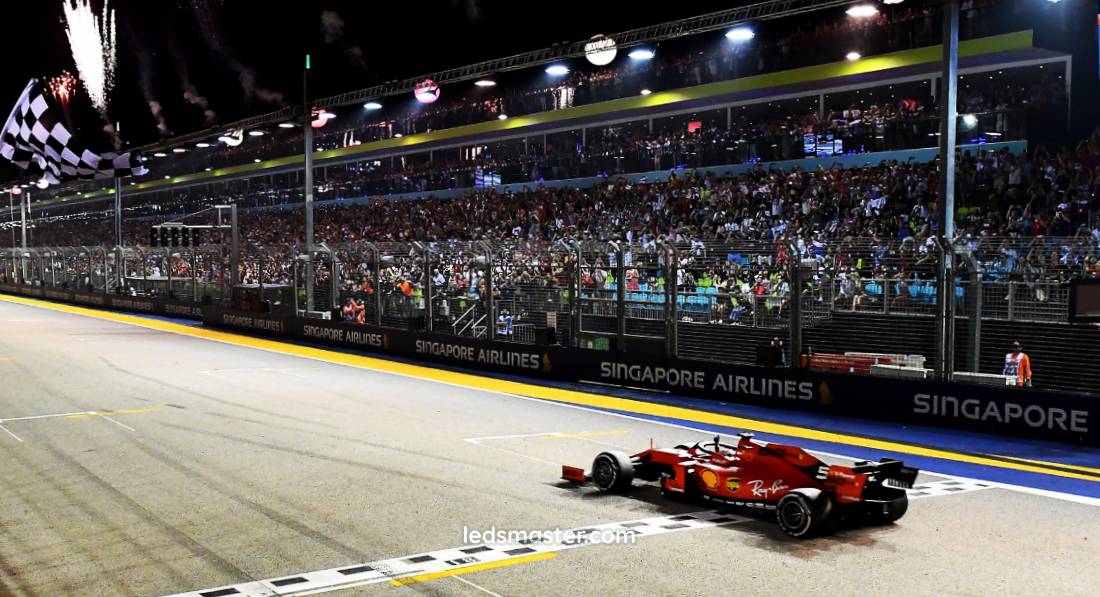
Envision a race track alive with excitement under the night sky, where dazzling lighting enhances the thrill of motorsport. As nighttime events gain popularity, effective race track lighting becomes crucial for safety and atmosphere. However, upgrading or installing these systems often involves navigating costs and funding challenges.
Get your complimentary lighting design today
As demand for night events increases, race track operators are often faced with the challenge of upgrading or installing new lighting systems, which can come with significant costs. By exploring the factors influencing lighting costs and available funding avenues, race track owners can make informed choices that enhance their facilities while maximizing financial sustainability.
| Cost Category | Details | Estimated Cost | Notes |
|---|---|---|---|
| Lighting Fixtures | 80 LED fixtures at $300 each | $24,000 | High-efficiency models |
| Light Poles | 20 poles at $1,200 each | $24,000 | Durable materials, suitable for weather |
| Installation Labor | Labor for installation (100 hours at $50/hr) | $5,000 | Skilled labor required |
| Electrical Upgrades | Upgrades to transformers and wiring | $10,000 | Necessary for new lighting system |
| Design and Consultation | Lighting design and engineering consultation | $3,500 | Professional design services |
| Site Preparation | Ground leveling and vegetation clearance | $2,500 | Preparing the area for installation |
| Miscellaneous Expenses | Permits, fees, and unexpected costs | $2,000 | Buffer for unforeseen expenses |
| Total Estimated Cost | $69,000 |
Table of Contents
ToggleSeveral factors contribute to the overall cost of race track lighting installations. Understanding these can help track owners budget effectively and choose the right system for their needs.
The choice of lighting type significantly impacts costs. LED lighting systems, while more expensive upfront, often lead to lower energy bills and reduced maintenance costs over time. On the other hand, metal halide and high-pressure sodium systems may be cheaper initially but can incur higher operational costs. Evaluating the long-term savings versus initial investment is vital when selecting a lighting system.

The installation process involves various expenses, including labor, equipment, and necessary modifications to the existing infrastructure. The complexity of the installation will depend on the track’s current layout and the chosen lighting system. Factors such as the height of the light poles, the distance between them, and the need for additional wiring or electrical work can influence labor costs.
The design of the lighting system itself plays a significant role in determining costs. Properly designed lighting ensures uniform illumination across the track, minimizing dark spots and enhancing safety. A well-planned lighting design may involve consultations with engineers and lighting specialists, adding to the overall project cost. Ensuring that the design meets both regulatory requirements and the needs of the venue can help track owners avoid costly modifications later.
Electrical infrastructure plays a vital role in determining the cost of a lighting installation. Upgrading the electrical system may be necessary to accommodate new lighting fixtures, particularly if switching from traditional systems to more energy-efficient options. This can involve installing new transformers, circuit breakers, and wiring capable of handling the increased load. Depending on the age and condition of the existing infrastructure, these upgrades can significantly affect the overall project budget.
Long-term maintenance costs should also be factored into the overall expenses of race track lighting. Different lighting systems have varying lifespans, affecting how often replacements are needed. LED fixtures typically require less maintenance than traditional options like metal halide or high-pressure sodium lights. However, all systems benefit from regular inspections and maintenance routines to ensure optimal performance and longevity.
Compliance with local building codes and regulations can impact the cost of lighting installations. Many jurisdictions have specific requirements regarding the type of lighting used, energy efficiency standards, and safety protocols. Understanding these regulations is essential to avoid fines and delays. Hiring professionals with experience in navigating local codes can streamline the process but may add to the upfront costs of the project.

Investing in a quality lighting system can yield long-term benefits that extend beyond immediate cost savings. Improved visibility enhances safety during races, reducing the risk of accidents caused by inadequate lighting. This not only protects drivers but also ensures the safety of spectators in the grandstands and surrounding areas. Furthermore, a well-lit track can enhance the overall experience for fans, leading to increased attendance and higher revenue for race organizers.
Maintaining the lighting system is another factor to consider in long-term planning. LED lights generally have longer lifespans compared to traditional fixtures, often lasting 50,000 hours or more. This durability translates to fewer replacements and reduced maintenance costs. However, regular inspections and maintenance should still be part of the operational plan to ensure the lighting system functions optimally throughout its lifespan.
The potential for hosting night events is another advantage of investing in advanced lighting systems. Many race tracks seek to increase revenue by offering evening races or events, which can draw larger crowds. Adequate lighting is essential for these events, and having a reliable system in place can position a track as a desirable venue for both drivers and fans. Enhanced visibility can also allow for events to be broadcasted more effectively, attracting sponsorship and advertising revenue.
Sustainability is becoming an increasing focus for race tracks, and investing in energy-efficient lighting systems aligns with this trend. The integration of solar panels with lighting systems can reduce reliance on traditional energy sources, further lowering operational costs. In some cases, race tracks are exploring energy storage solutions that allow them to store energy generated during the day for use during night events.
Various funding sources are available for race track lighting projects, ranging from private investments to public grants. Exploring these options can provide track owners with the financial resources needed to enhance their facilities.
Private investments can play a significant role in funding race track lighting projects. Many race tracks partner with local businesses or corporations that see value in sponsoring the facility or specific events. These sponsorships often include financial contributions in exchange for advertising opportunities, such as prominently displaying the sponsor’s logo on signage around the track or in promotional materials. By forging partnerships with businesses that align with their target audience, track owners can secure essential funding while enhancing the visibility of their sponsors.
Additionally, private investors may be willing to fund lighting projects if they believe in the potential profitability of the race track. Presenting a solid business plan that outlines the anticipated return on investment (ROI) from improved attendance and revenue from night events can attract interested investors. Creating a compelling case for how upgraded lighting can enhance the track’s marketability is crucial for securing private funding.

Government grants and public funding can also provide valuable resources for race track lighting projects. Many local, state, and federal agencies offer grants aimed at improving community facilities and promoting economic development. These grants may be available for projects that enhance safety, accessibility, or sustainability. Track owners should thoroughly research the types of grants available in their area and identify which programs align with their lighting project goals.
In addition to grants, public funding initiatives may provide low-interest loans or financing options for facility upgrades. Some programs focus on energy efficiency improvements, encouraging race tracks to invest in sustainable lighting solutions. Applying for these funding sources typically involves a detailed proposal outlining the project’s goals, expected outcomes, and how it aligns with the funding agency’s objectives. Engaging with local government representatives can provide insight into available programs and the application process.
Crowdfunding has emerged as a popular funding method for various projects, including race track lighting upgrades. Through online platforms, track owners can solicit small contributions from a large number of individuals who are passionate about motorsports and the local racing community. To successfully engage potential backers, it is important to create a compelling campaign that highlights the benefits of improved lighting for both the track and the community.
Community engagement is also critical in this funding approach. Hosting events or informational sessions can help rally support from local residents and racing enthusiasts. By demonstrating how enhanced lighting can create a safer, more enjoyable environment for all stakeholders, track owners can cultivate a sense of ownership and pride within the community. Engaging local media to cover the campaign can further amplify awareness and encourage contributions.
Developing a comprehensive budget for race track lighting projects is essential for effectively managing costs and securing funding. A well-structured budget allows track owners to present a clear financial picture to potential investors, sponsors, or grant providers.
Estimating the total costs associated with the lighting project is the first step in budgeting. This includes not only the purchase and installation of the lighting system but also potential upgrades to electrical infrastructure, site preparation, and ongoing maintenance costs. Track owners should conduct thorough research to obtain accurate quotes from lighting suppliers, contractors, and engineers. Creating a detailed project proposal that outlines all anticipated expenses will demonstrate to funders the financial viability of the project.
Once costs are estimated, track owners must allocate resources wisely to ensure all aspects of the project are funded adequately. This may involve prioritizing certain elements, such as selecting high-efficiency lighting systems that may have higher upfront costs but offer significant long-term savings. Determining the appropriate allocation of funds across different project components will help maintain financial control throughout the installation process.
Throughout the project, it is crucial to monitor spending and adjust the budget as needed. Unexpected expenses may arise during the installation process, and track owners should have a contingency plan in place to address these issues. Regularly reviewing the budget against actual expenditures will allow for timely adjustments and help ensure that the project stays on track financially.
Investing in race track lighting is a complex but rewarding process that enhances safety, visibility, and the overall spectator experience. Various factors, including the type of lighting technology and installation requirements, can significantly impact costs. Securing funding from diverse sources, such as private investments and public grants, is essential for making these projects financially viable. By developing a comprehensive budget and exploring potential revenue streams, race track operators can ensure the long-term sustainability of their lighting systems. Ultimately, thoughtful planning and execution of lighting upgrades can lead to a more competitive and vibrant motorsports environment.